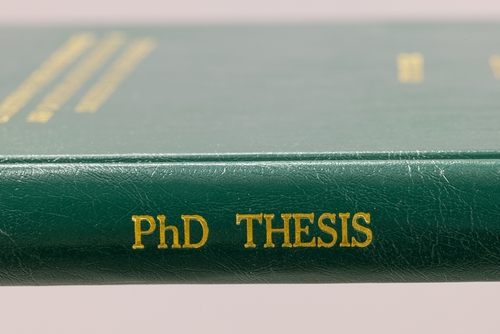
If you are passionate about your field, you may decide to get a Ph.D. Such a purpose will require much effort, time, and focus from you because it involves a long-term commitment and writing a well-researched thesis.
Before making this commitment, it’s good to consider what kind of work is waiting for you when you start your Ph.D. quest. For this reason, we have prepared a guide explaining all the most significant aspects of being involved in such a research project and what the anatomy of a Ph.D. thesis is.
Related Resource: How to Get Ph.D. Funding
What is a Ph.D.?
A Ph.D. simply stands for “Doctor of Philosophy.” It doesn’t mean you’re about to become a doctor or a philosopher. Let’s look at the meaning of these words and where they come from. In Ancient Greek, the term “Philosophia” meant the love of wisdom.
A doctor, in this case, refers to someone who holds the highest possible degree at an educational institution. It also means that they can teach, and the word has its roots in the Latin word for “teacher.”
Therefore, a Doctor of Philosophy is someone who holds the highest degree for the love of wisdom, research, and knowledge – in their specific narrow field. There are PhDs in the sciences, mathematics, humanities, arts, or other fields.
Let’s go back and look at what a thesis looks like:
Original Research
The first step of getting a Ph.D. is deciding what your thesis is supposed to be about. Select a general area you want to explore, and then search for ideas to conduct an original research project.
Students should devote much time to developing their general knowledge first and then focus on the specified subject they want to write about. It should be something that has not yet been explored before so that it can contribute to the world of science by providing some new insights.
It can be challenging for a graduate student to become a serious researcher, but the Ph.D. program completion depends on the research conducting ability. To collect the necessary data and literature, it is essential to get access to professional publications.
Usually, they are available to students through their university, but it may happen that they will have to cover a fee to get subscriptions to research databases. Nevertheless, it is worth taking that step because science articles are an irreplaceable source of knowledge and can be amazingly helpful in exploring your study area and writing a Ph.D. thesis.
Remember to concentrate on the latest technologies and discoveries when researching your topic. When you find a source, always remember to check when it was written because using outdated information will not be good for your thesis.
If you find research papers written a decade ago or even before, you should ensure that the data included in them is still valid. You certainly do not want your thesis to be outdated! It is supposed to provide a fresh approach to a subject and a different perspective helping to understand a given subject deeper.

Thesis Proposal Creation
Another crucial step in writing a thesis is creating a proposal and presenting it to your professors. To make it right, graduate students need to outline the question that they intend to answer with their research. It is highly recommended that the subject be unique to avoid simply rewriting the data that has already been gathered, analyzed, and presented by other scholars.
It is understandable that with that much research already being done, it may be difficult for you to develop an original research project. Keep in mind that it does not have to be absolutely unique, but the crucial thing is that you should approach it from a different angle. What is more, remember to select a very specific subject instead of a broad area of knowledge.
Thesis Length
Thesis length is the aspect that scares off many people – to get a Ph.D., you must come up with quite a long piece of writing. Students are often afraid that they will not find enough literature to meet the required length, but usually, when they start their research, it turns out that there are plenty of sources to use and many ideas they can develop.
The actual minimum thesis length can differ from one university to another, so you should always check the requirements of a particular institution and program.
You should not feel too discouraged with the thesis length because it is worth its effort. It allows graduate students to earn a Ph.D. and, as a result, work as science researchers and university professors or even become top experts in their areas of expertise.
Thesis Structure

Every thesis should follow the specific structure standards to be more readable, professional, and easy to go through. If there are small alterations, usually it is fine, but you should bear in mind to be as close to your university expectations as possible.
By shaping the results of your work in a properly edited piece of writing, you are more likely to meet your supervisor’s requirements.
Let’s go through a Ph.D. thesis structure!
An Abstract
An abstract is a concise summary that gives the reader a general idea of what your thesis is going to be about. It should summarize all the sections of your work and present its contribution. Thanks to a Ph.D. abstract, it is clear from the beginning how beneficial for a particular field your thesis is.
While creating an abstract, you should ask yourself a few questions, such as:
Why did you write the thesis on this specific subject?
What questions and purposes have you tried to address?
How does the present literature approach this topic?
Are there any gaps in this field that need covering?
What was your methodology?
What are the most significant ideas you managed to come up with?
What conclusions and implications did you reach?
It is crucial to remember that even though an abstract is the initial part of your thesis, you should not start writing your work with it. It should be prepared when all the study has been finished and when you know exactly what your text looks like in its final shape. Normally, along with the acknowledgments, it is the last thing you are supposed to write in your thesis.
Moreover, you should remember that an abstract cannot be too long (you need to respect the word limit), so there is not too much space to cover all the aforementioned questions. For this reason, you should keep it short and focus on what is most important. Save your space by avoiding quotations and repeating the title.
Also, bear in mind that the first impression of your Ph.D. thesis will depend on your abstract, so write it in clear, short sentences. Do not be vague (every word there should be meaningful), and do not try to explain your whole theoretical section. Apart from that, avoid overstatement, do not go beyond what is in the thesis, and edit the whole piece carefully.
An Introduction
With an introduction, you should establish your area of expertise, justify your niche and explain why your research is important for the field. After familiarizing themselves with a perfectly written introduction, readers should fully understand what the thesis will be about. You should stress your topic there and explain why your writing is important to the world of science.
Furthermore, inform the reader how you conduct your research and what the layout of your thesis is so that they know what to expect. Again, the vital part here is stressing your contribution to science – you need to convince the examiner that your fresh approach will make the field better developed.
A Literature Review
If you were working on an invention, you would have to take a look at what has been invented already to make sure that your discovery will be revolutionary and notice the flaws that your work could fix.
Also, you would have to know how other people approached their tasks and what was good to use in your work. It is the same case with the literature review – you need to know what research has already been done in your field (and sometimes beyond) to refer to it in your thesis.
The main purposes of preparing a literature overview are as follows:
- Summarizing what has already been surveyed in your area, both to prove that you know it very well and to demonstrate that you are the results of your work relate to the previously made research
- Naming crucial theories, methods, studies, and theoretical frameworks that influenced your thesis
- Emphasizing flaws, shortcomings, or difficult issues in the existing research to show how your thesis can contribute to improving the field.
When conducting a literature review, choose a broad subject to find the way in. Then, take your time familiarizing yourself with what was already said, when and by whom, and take notes.
Next, narrow down the field and the sources, and think about what questions can be asked to the already made research. Answering some of them can be the purpose of your thesis!
A Theoretical Framework Chapter

The theoretical framework is significant for your thesis because it serves as the foundation of your research. So should write it in such a way so that the reader could know:
- the theoretical concepts you have used in your research
- the reason why you have selected this particular theory
- the results of applying this theory
- the relationship between the theory and the already written literature, as well as its applications in other similar contexts
- the difference between your thesis and the previous existing research
- the relationship between particular concepts within the model (maybe even its visual depiction)
- the ways you implement the theory and analyze the concepts, referring to the literature review
Thanks to the theoretical framework, your empirical data will be more obviously connected to the existing study. What is more, it will prove that your thesis has a solid scientific basis and show what are the hypotheses and concepts that still need to be discussed in the field.
In a theoretical framework, you can expose assumptions that still need additional research and indicate that your Ph.D. thesis is supposed to provide answers to the questions that still need them.
You should not be too general here, though, but just mostly focus on a small subset of concepts that you are going to deal with. This section is like a tool that a graduate student is going to use to “fix” the problem that they have noticed in the literature review.
To show the examiner that you understand your area of expertise well, you should remember to include the concepts made by the most renowned theoretical schools in your field.
Despite their status, you should not agree with them blindly but show that you have gathered some data showing their assumptions might be challenged. It will show that you have a fresh approach to your writing instead of just repeating what others have said.
Nevertheless, to disagree with something, you need to know it well, so demonstrating your deep theoretical background will be great for your thesis.
A Methods Chapter
The methods chapter will likely be the most descriptive section of your thesis. However, you should know that not every thesis requires such a section – if the methods are pretty straightforward, a student does not have to explain them in detail.
The purposes of a methods chapter are:
- Presenting the techniques you have implemented to gather all the information necessary to discuss your subject.
- Explaining why the methods you have selected are suitable for the objectives of your work
- Showing how your approach relates to the techniques applied by other researchers in similar contexts
Thanks to this section, a reader will know in what way you managed to reach your results and why you decided to write about this particular subject. Also, it will provide the justification for selecting one approach over all the others and show the relation to your ontological and epistemological positions.
It will also make your thesis more reliable as it will explain when and from whom you got the information and the tools used to conduct the analysis.
An Empirical Chapter
Empirical writing is one of the most straightforward sections of a thesis. Some readers may consider it too technical and skip over many details; nevertheless, after familiarizing themselves with it, at least generally, they should find out about the results of your investigations and their relationship with the preceding studies.
It is vital to mark there if something was more surprising than you expected or if maybe something did not go as it was planned. Also, a graduate student should tell what led them to come up with this particular conclusion. What is more, they should think about any specific categories or themes that emerge from the gathered information.
However, remember that you should just present your findings but not discuss them yet – there is another chapter for that.

A Discussion Chapter
As the name suggests, it is the section where you can finally discuss your findings. For many students, this is the most difficult part of working on their Ph.D. because it demands speaking like an actual scholar and pushing the already established boundaries of knowledge.
It is probably the first time you are supposed to do this because, in your graduate and undergraduate work, you have probably just presented what other people have come up with. Now it is time to present your own discoveries! That is the moment when a student is starting to become a Ph.D. scholar.
A Conclusion
The main task of the conclusion is to emphasize the answers you managed to find to your research questions. What is more, you should present how the research you have done is relevant to the objectives of your thesis. Also, do not forget to stress the importance of your work.
However, you should be able to see its shortcomings as well and not be afraid to mention them. There is nothing wrong with you not covering everything – your thesis must come to an end sooner or later, but you can suggest what should be explored more by other researchers in the future.
After all the work you have done, you need to be confident while writing your conclusion. Every chapter is a part of one bigger whole, and the conclusion is what joins them all. You can briefly recap the questions along with their answers and discuss the contribution your research has made to the field.
Keep in mind that the conclusion should be made along with the results and discussion chapters so that the reader has a sense of harmony. That is the last thing your examiner will read after all, so it can affect the final impression to a large extent!
Bonus Info: What’s the Difference Between a Thesis and a Dissertation?
Doctoral Dissertation vs. Thesis
Some people treat the words ‘thesis’ and ‘dissertation‘ as synonyms, but in fact, there are some differences. However, it may depend on, for example, the subject area. What is more, it can depend on whether you are in the USA or in the UK.
Generally, students just need to check how their university refers to such a piece of writing because every institution may use its own terminology. When you plan to get a Ph.D., you will need to get much information about such a project anyway, and the choice of whether to call it a ‘thesis’ or a ‘dissertation’ is one of the things you should know about from the start.
Online Ph.D. Courses
To write a thesis, you definitely need a lot of time. However, you should know that now you do not have to attend classes in-person to complete the course. Thanks to our offer, you can work on your Ph.D. from home and not waste your time traveling to the university and back.
We have prepared a wide offer of specializations for you to choose from, so you will definitely find something that fits your interests. For example, you can select Business & Management, Liberal Arts & Humanities, Nursing & Healthcare, and many more.
Such courses are a very convenient solution because they can be perfectly adjusted to your lifestyle and your needs. It does not matter if you are a devoted parent or an engaged businessperson: you have the flexibility to manage your workload.
We will provide you with all the essential help and guide you throughout the process. You don’t have to postpone your dream of getting a Ph.D. – just think about the thesis you would like to write, and sign up for our online course!
Additional Info: The 10 Best No-GRE Online Ph.D. Programs
